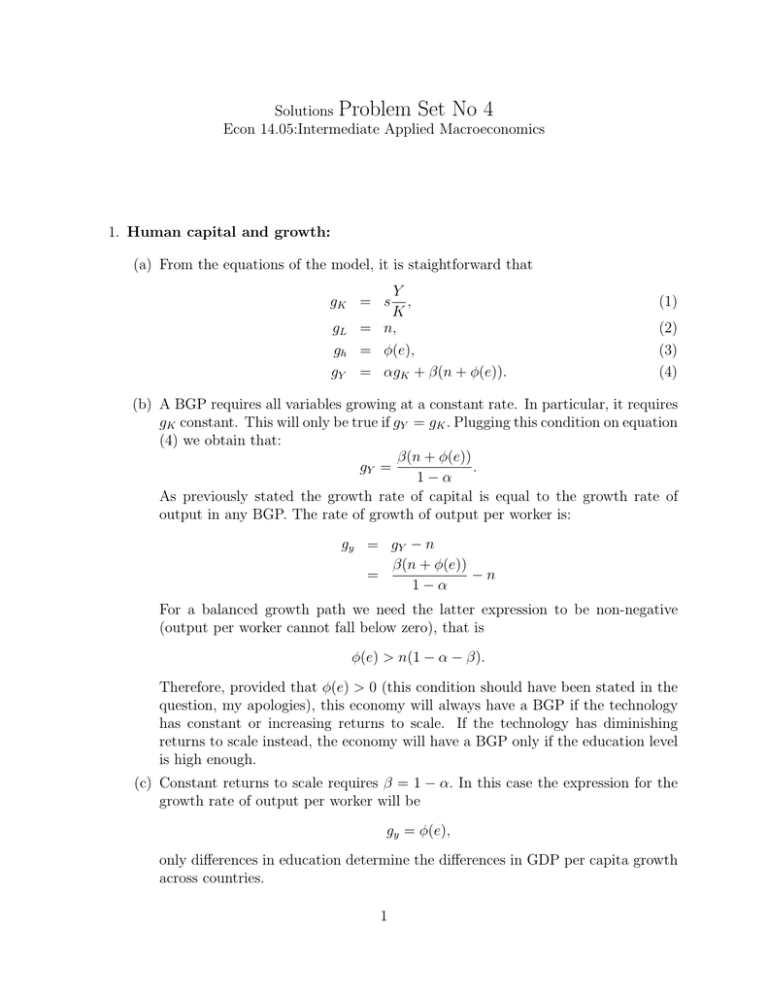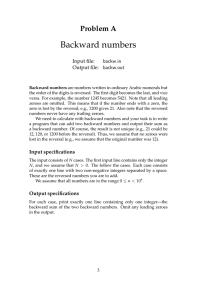Document 12875824
advertisement

Solutions Problem Set No 4 Econ 14.05:Intermediate Applied Macroeconomics 1. Human capital and growth: (a) From the equations of the model, it is staightforward that Y , K = n, = φ(e), = αgK + β(n + φ(e)). gK = s (1) gL gh gY (2) (3) (4) (b) A BGP requires all variables growing at a constant rate. In particular, it requires gK constant. This will only be true if gY = gK . Plugging this condition on equation (4) we obtain that: β(n + φ(e)) gY = . 1−α As previously stated the growth rate of capital is equal to the growth rate of output in any BGP. The rate of growth of output per worker is: gy = gY − n β(n + φ(e)) = −n 1−α For a balanced growth path we need the latter expression to be non-negative (output per worker cannot fall below zero), that is φ(e) > n(1 − α − β). Therefore, provided that φ(e) > 0 (this condition should have been stated in the question, my apologies), this economy will always have a BGP if the technology has constant or increasing returns to scale. If the technology has diminishing returns to scale instead, the economy will have a BGP only if the education level is high enough. (c) Constant returns to scale requires β = 1 − α. In this case the expression for the growth rate of output per worker will be gy = φ(e), only differences in education determine the differences in GDP per capita growth across countries. 1 (d) Under From this output study, time this reduces rate of level of immediately in e should long run. 2. The role of (a) The new implies capital standard k Figure 1: 2 · (b) Now we have k(t) = sB(1 − τ )k α − (n + δ)k = sτ β k αβ (1 − τ )k α − (n + δ)k = sτ β (1 − τ )k α(1+β) − (n + δ)k. That implies that the growth rate is gk = sτ β (1 − τ )k α(1+β)−1 − (n + δ). Consequently, what happens in the long run depends on wether α(1 + β) � 1, or which is the same, β � 1−α . If β > 1−α then α(1 + β) > 1, α α which implies that as we accumulate capital, marginal product increases every time more and more. So we have increasing marginal product. The growth rate then α(1 + β) < 1, which increases forever and the economy explodes. If β < 1−α α implies that although marginal product is not as decreasing as before, it still is decreasing. As we know, this implies the economy converges to a long run level of capital per effective labor because this is nothing more than the standard Solow . In that case gk = sτ β (1−τ )−(n+δ), model. The interesting case is when β = 1−α α which implies we have a constant growth rate for the level of capital per effective worker. We have endogenous growth! , gk = sτ β (1 − τ ) − (n + δ). If we maximize this with (c) In the case with β = 1−α α respect to τ, the F.O.C. is sβτ β−1 (1 − τ ) − sτ β = 0 ⇔ βτ −1 (1 − τ ) = 1 ⇔ β . τ∗ = 1+β Why is there a τ that maximizes growth? τ has two effects. It takes resources away from the private economy, which reduces growth. But the government uses the taxes for producing goods, say roads, that create an externality to private production, and this increases growth. The higher is β, the more productive is the government relative to the private sector, and the bigger should be the tax. · (d) In that case we know k(t) = s(1 − τ )k α − (n + δ)k. This means that we only have the negative effect of taxation as the government is stealing the taxes. In that case endogenous growth does not arise because there are no externalities and we have a lower capital than without government. This model helps understanding how different governments affect the long run properties of a economy. In countries with corrupt governments, the economy will stagnate, while in countries with productive governments, high growth rates can be sustained. 3. Appropriate technology and the role of education (a) If we take logs in the expression for the growth rate of technology we get log gA = log A − log A∗ + log g ∗ . Differentiating with respect to time we get · · · ∗ gA A A = − ∗ = gA − gA∗ . gA A A And using the expression for gA we get · A gA A = ∗ g ∗ − g ∗ = ( ∗ − 1)g ∗ , gA A A 3 which is negative as we assumed A < A∗ . So the country starts with a lower growth rate, and the growth rate decreases over time. This means that the distance of the country to the world technology increases over time, technologies diverge. This tell us that if you need certain amount of technology to understand new technologies, poor countries with backward initial technologies not only won’t catch up with the rest of the world, but they will diverge for ever. (b) Now the backward country starts with a bigger growth rate as A < A∗ and . gA = A(t) A(t) = A(t)∗ ∗ g . A(t) Following the same steps as before we get: · A(t)∗ ∗ gA A(t)∗ ∗ g = (1 − )g = gA∗ − gA = g ∗ − gA A(t) A(t) which is negative and goes to 0 as A approaches A∗ . So the backward country starts with a higher growth rate than the world, and the growth rate decreases as this country gets closer to the growth frontier. This keeps going until it catches up. So in that case we have convergence in the growth rates and the levels of technology. (c) The expression for the growth rate of the growth rate is now · A(t)∗ ∗ gA A(t)∗ ∗ ∗ ∗ = gA − gA + e = g − g + e = (1 − )g e gA A(t) A(t) which can be positive now. So, among backward countries, those with high levels of human capital growth may catch up with the world, while those with little growth in human capital will diverge forever. (d) We already discussed all the mechanisms. Both mechanisms might be relevant in the real world. It is quite intuitive that some technologies are not appropriate for the poor countries because they are developed in the rich countries, and the poor lack the human capital, and their technology is too backward to fully benefit of these new technologies. But it also makes sense to think that, the more backward a country is, the more it can benefit from innovations. We could recommend a backward country to accumulate human capital by putting in place an appropriate education system and making sure it is actually used. 4



